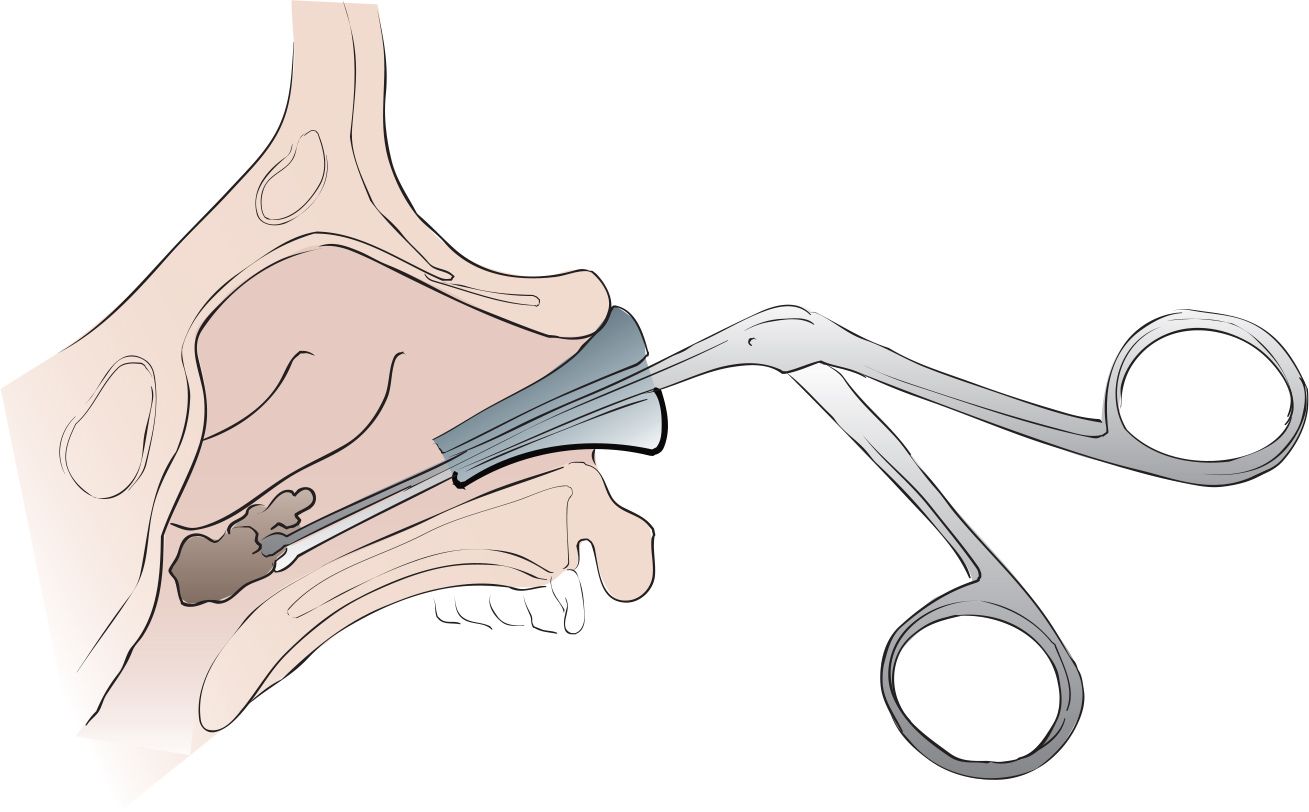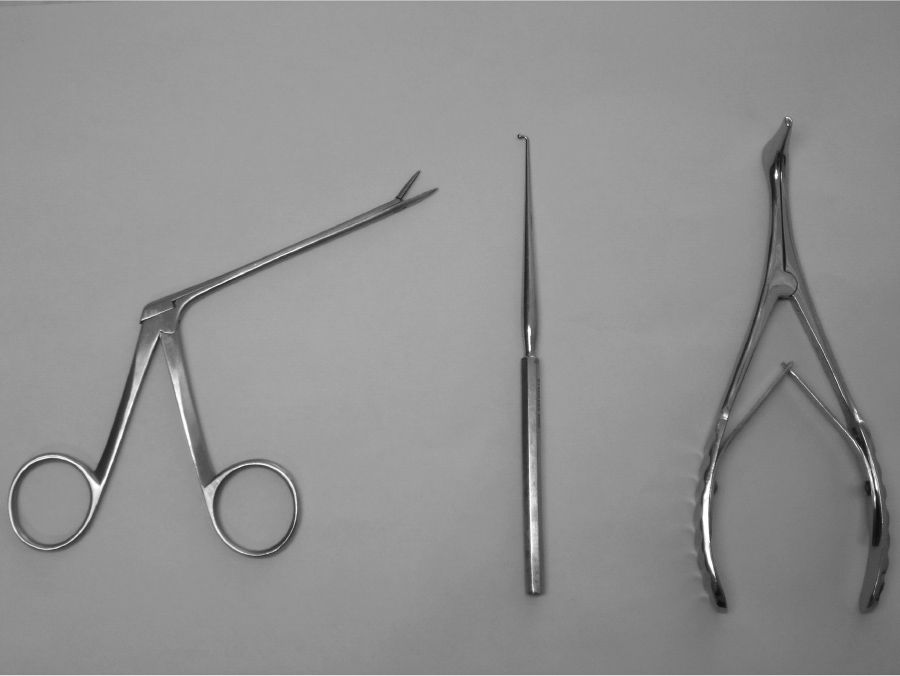![]() Presence of foreign material within the nostril
Presence of foreign material within the nostril
CONTRAINDICATIONS
![]() If the foreign body entered the nose traumatically and there is concern it has penetrated the cranial cavity
If the foreign body entered the nose traumatically and there is concern it has penetrated the cranial cavity
![]() If there is danger of obstructing the airway
If there is danger of obstructing the airway
![]() General Basic Steps
General Basic Steps
![]() Patient preparation
Patient preparation
![]() Anesthesia
Anesthesia
![]() Choose method of removal
Choose method of removal
TECHNIQUE
![]() Patient Preparation
Patient Preparation
![]() An uncooperative child should be properly immobilized or sedated
An uncooperative child should be properly immobilized or sedated
![]() An option is to papoose the child in a blanket in the supine position with the arms at the sides and an assistant holding the head still
An option is to papoose the child in a blanket in the supine position with the arms at the sides and an assistant holding the head still
![]() Using a syringe as a dropper, instill either lidocaine and phenylephrine or lidocaine with epinephrine in the nostril to optimize the visual field and provide anesthesia, decongestion, and hemostasis
Using a syringe as a dropper, instill either lidocaine and phenylephrine or lidocaine with epinephrine in the nostril to optimize the visual field and provide anesthesia, decongestion, and hemostasis
![]() Dosing for nasal phenylephrine
Dosing for nasal phenylephrine
![]() 6 months to 2 years: 1 to 2 drops per nostril of a 0.1255 solution
6 months to 2 years: 1 to 2 drops per nostril of a 0.1255 solution
![]() 2 to 6 years: 2 to 4 drops per nostril of a 0.1255 solution
2 to 6 years: 2 to 4 drops per nostril of a 0.1255 solution
![]() Older than 6 years: 2 to 3 drops per nostril of a 0.1255 solution
Older than 6 years: 2 to 3 drops per nostril of a 0.1255 solution
![]() Make sure you have a good light source and suction
Make sure you have a good light source and suction
![]() Consider anxiolysis or sedation in the uncooperative child, especially in those who require more urgent removal of the foreign body, as in the case of button batteries
Consider anxiolysis or sedation in the uncooperative child, especially in those who require more urgent removal of the foreign body, as in the case of button batteries
Methods of removal |
Manual removal |
Suction catheter |
Positive pressure |
Foley catheter |
Cyanoacrylate glue |
Nasal wash |
![]() Manual Removal
Manual Removal
![]() A directly visualized object can be removed with alligator forceps or a curette with or without the assistance of a nasal speculum
A directly visualized object can be removed with alligator forceps or a curette with or without the assistance of a nasal speculum
![]() Alligator forceps are best used for easily grasped, solid or compressible (e.g., paper) objects in the anterior nostril
Alligator forceps are best used for easily grasped, solid or compressible (e.g., paper) objects in the anterior nostril
![]() A round and smooth object may be removed with an angled wire loop/curette or right-angle hook. It is inserted along the nasal floor or septum until it is behind the object and rotated so that the angled end is caught behind the object; the object can then be pulled out (FIGURES 87.1 and 87.2).
A round and smooth object may be removed with an angled wire loop/curette or right-angle hook. It is inserted along the nasal floor or septum until it is behind the object and rotated so that the angled end is caught behind the object; the object can then be pulled out (FIGURES 87.1 and 87.2).

FIGURE 87.1 Removal of an intranasal foreign body using forceps. (From Issacman DJ, Post JC. Nasal foreign body removal. In: Henretig FM, King C, eds. Textbook of Pediatric Emergency Procedures. Philadelphia, PA: Williams & Wilkins; 1997:684, with permission.)
![]() If no wire loop is available, a makeshift one can be constructed with a paperclip (FIGURE 87.3)
If no wire loop is available, a makeshift one can be constructed with a paperclip (FIGURE 87.3)
![]() Suction Catheter
Suction Catheter
![]() Using a small suction catheter connected to wall suction, gently put the suction catheter up to the visible side of the object
Using a small suction catheter connected to wall suction, gently put the suction catheter up to the visible side of the object
![]() Be careful not push the object further back
Be careful not push the object further back
![]() When the object becomes attached to the end of the suction catheter, slowly withdraw both the catheter and the foreign body
When the object becomes attached to the end of the suction catheter, slowly withdraw both the catheter and the foreign body
![]() Rigid suction catheters usually work better than flexible catheters
Rigid suction catheters usually work better than flexible catheters
![]() The presence of side holes will prevent the vacuum from occurring at the tip. Choose a catheter without side holes, or trim the catheter tip to remove the side holes, leaving only an end opening.
The presence of side holes will prevent the vacuum from occurring at the tip. Choose a catheter without side holes, or trim the catheter tip to remove the side holes, leaving only an end opening.
![]() Trim any sharp edges from the cut end to prevent trauma
Trim any sharp edges from the cut end to prevent trauma
![]() Positive Pressure
Positive Pressure
![]() The parent or the physician can do this technique. The parent may assist with this procedure and therefore reduce the child’s anxiety.
The parent or the physician can do this technique. The parent may assist with this procedure and therefore reduce the child’s anxiety.
![]() Instruct the parent to gently occlude the nostril without the foreign body with finger pressure
Instruct the parent to gently occlude the nostril without the foreign body with finger pressure
![]() Give one quick puff of air into the child’s mouth
Give one quick puff of air into the child’s mouth
![]() To put the child at ease, the parent can say she/he is going to give the child a big kiss
To put the child at ease, the parent can say she/he is going to give the child a big kiss
![]() The puff of air should push the foreign body out of the nostril
The puff of air should push the foreign body out of the nostril
Stay updated, free articles. Join our Telegram channel

Full access? Get Clinical Tree



